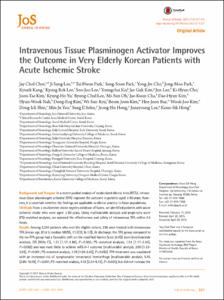Intravenous Tissue Plasminogen Activator Improves the Outcome in Very Elderly Korean Patients with Acute Ischemic Stroke
- Keimyung Author(s)
- Sohn, Sung Il; Hong, Jeong Ho
- Department
- Dept. of Neurology (신경과학)
- Journal Title
- Journal of Stroke
- Issued Date
- 2015
- Volume
- 17
- Issue
- 3
- Abstract
- Background and Purpose In a recent pooled analysis of randomized clinical trials (RCTs), intravenous tissue plasminogen activator (TPA) improves the outcome in patients aged ≥80 years. However, it is uncertain whether the findings are applicable to clinical practice in Asian populations.
Methods From a multicenter stroke registry database of Korea, we identified patients with acute ischemic stroke who were aged ≥80 years. Using multivariable analysis and propensity score (PS)-matched analyses, we assessed the effectiveness and safety of intravenous TPA within 4.5 hours.
Results Among 2,334 patients who met the eligible criteria, 236 were treated with intravenous TPA (mean age, 83±5; median NIHSS, 13 [IQR, 8-17]). At discharge, the TPA group compared to the no-TPA group had a favorable shift on the modified Rankin Scale (mRS) score (multivariable analysis, OR [95% CI], 1.51 [1.17-1.96], P=0.002; PS-matched analysis, 1.54 [1.17-2.04], P=0.002) and was more likely to achieve mRS 0-1 outcome (multivariable analysis, 2.00 [1.32-3.03], P=0.001; PS-matched analysis, 1.59 [1.04-2.42], P=0.032). TPA treatment was associated with an increased risk of symptomatic intracranial hemorrhage (multivariable analysis, 5.45 [2.80-10.59], P<0.001; PS-matched analysis, 4.52 [2.24-9.13], P<0.001), but did not increase the creatiin-
hospital mortality (multivariable analysis, 0.86 [0.50-1.48], P=0.58; PS-matched analysis, 0.88
[0.52-1.47], P=0.61).
Conclusions In the setting of clinical practice, intravenous TPA within 4.5 hours improved the
functional outcome despite an increased risk of symptomatic intracranial hemorrhage in very elderly
Korean patients. The findings, consistent with those from pooled analysis of RCTs, strongly
support the use of TPA for this population.
- Publisher
- School of Medicine
- Citation
- Jay Chol Choi et al. (2015). Intravenous Tissue Plasminogen Activator Improves the Outcome in Very Elderly Korean Patients with Acute Ischemic Stroke. Journal of Stroke, 17(3), 327–335. doi: 10.5853/jos.2015.17.3.327
- Type
- Article
- ISSN
- 2287-6391
- Appears in Collections:
- 1. School of Medicine (의과대학) > Dept. of Neurology (신경과학)
- 파일 목록
-
-
Download
 oak-2015-0134.pdf
기타 데이터 / 442.48 kB / Adobe PDF
oak-2015-0134.pdf
기타 데이터 / 442.48 kB / Adobe PDF
-
Items in Repository are protected by copyright, with all rights reserved, unless otherwise indicated.